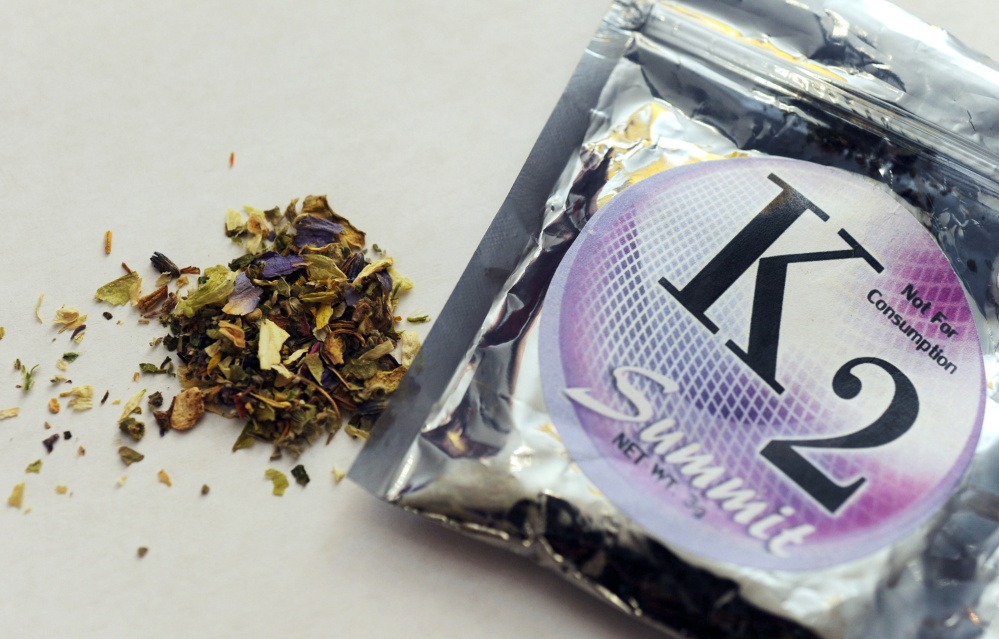On most Sundays, when the social service agencies in Portland’s Bayside neighborhood are closed, it’s common to find a large group of people gathered outside an abandoned building at the intersection of Oxford and Cedar streets.
They sit or stand mostly in silence, their heads and sometimes even their entire upper torsos bent at a nearly 90-degree angle to the ground. If their eyes are open, the pupils are fixed in a blank, disassociated stare.
“It’s like a scene out of ‘The Walking Dead,’ ” said outreach worker Joe McNally, referring to the popular cable television show about zombies.
The zombie-like state, which lasts for up to a half-hour, is a telltale marker of the synthetic drug spice, sometimes called K2. It’s been around for several years but has seen a sudden resurgence in Portland in the last few months, according to police, health officials and workers like McNally, who works for Milestone Foundation.
Some big cities, including New York and Los Angeles, have seen increasing issues related to spice as well.
Originally marketed as synthetic marijuana and sold legally over the counter in head shops and convenience stores, the drug has morphed into a much more powerful and addictive substance. Efforts to ban it have been largely unsuccessful because the chemical compounds keep changing.
In Portland, use of spice isn’t limited to Sundays. Most afternoons and evenings in the area of Bayside that has come to be known as “Spice Alley,” people can be seen using openly. Police patrol regularly, but the drug is technically legal so there isn’t much officers can do. That also makes it difficult to quantify the problem. Police don’t arrest for spice possession. And when ambulances are called, they don’t necessarily log the drug involved unless it’s an overdose.
The only indications of the drug’s surge come from anecdotes from outreach workers.
At a time when the heroin/opiate epidemic has gripped Maine and other parts of the country, the risk is always there that new drugs will take hold. Spice has become popular in Portland because of simple economics. It’s abundant – people can buy it online in bulk from unregulated websites – and it’s cheap – $10 for a packet of spice that might yield two to three joints. Its users are mostly the downtrodden – homeless or transient men and women who have nowhere else to go and little hope that their situation is going to change.
Alicia, a 27-year-old who asked that her last name not be published because she didn’t want her family to be embarrassed, said she’s used every drug out there: heroin, crack, acid, pills. Nothing has hit her as hard as spice.
“You just don’t know what’s in it,” she said last week. “But the withdrawal is unlike anything else. You start puking and (defecating) yourself. It’s awful. When you use again, it’s not necessarily because you want to but because you have to.”
McNally, whose job is to meet drug users wherever they are, to keep them as safe as possible, and to let them know about various services, said he’s worried about the long-term effects of the drug. But the short term is a concern, too. Although most users are not a threat to anyone, some have been wandering in and out of busy streets, and ambulances are being called more and more to Spice Alley to treat people who have gotten sick.
In extreme cases, users suffer seizures and collapse. Some hallucinate. Once the high wears off, users become highly irritable.
“Right now, the risk isn’t necessarily in overdoses, although that certainly can happen,” said Oliver Bradeen, who heads up the Portland Police Department’s Law Enforcement Addiction Advocacy Program, or LEAAP. “The risk is that we really don’t know what we’re dealing with or how bad it’s going to get.”
CONTENT UNKNOWN
When Bradeen started his job in February, he heard little about spice. By April, it was everywhere.
The drug is made by spraying psychoactive chemicals onto plant matter and then smoking it. But what’s in those chemicals is unknown.
By 2014, all 50 states had adopted some sort of ban on synthetic drugs such as spice, but those laws are hard to enforce because the molecular structure of the drugs keeps changing.
The drug is still available for purchase in some head shops around the city, but Bradeen said most of the spice that’s on the streets of Portland is purchased online in bulk, likely from China or India.
Many packages even say clearly “not for human consumption,” but that doesn’t deter people.
Bradeen and McNally said spice users tend to be either opiate users who are looking to amplify the effects of heroin or fentanyl or former opiate users who have switched to spice exclusively.
Alicia said she only uses spice now. Asked if she was scared not knowing what’s in the drug, she said, “Of course.” But she doesn’t see herself stopping anytime soon, either. Her teeth and fingertips are stained brown from handling the drug.
Although it looks like marijuana and is consumed the same way, spice produces an entirely different high, she said. When it burns, it smells like charred plastic mixed with hair.
“There are no needles, though,” Alicia said.
Other metropolitan areas across the country have seen increased use of spice. The New York Times reported in July that 33 people in Brooklyn were admitted to local hospitals for suspected overdoses connected to spice. In April, in Los Angeles, 15 people were hospitalized after consuming a tainted batch of the drug. In January, former New England Patriots defensive end Chandler Jones was hospitalized after having a bad reaction to spice.
In Bayside, spice is used openly. On a recent weekday, a group of three men packed a bowl on the sidewalk and passed it back and forth. When a police officer rode by on a bicycle, the men made no effort to hide.
Steve Hirshon of the Bayside Neighborhood Association said he’s been hearing about spice since the spring.
“Every year has its new fashion,” he said. “I think probably the rash of opiate overdoses and deaths has scared a lot of people – although not enough to get them to stop using something.”
Hirshon said there is little his association can do other than monitor activity on the streets and work with police as concerns come up.
“Everyone is sort of throwing up their hands at this,” he said.
LOCALIZED IN PORTLAND
McNally and other outreach workers for Milestone readily admit they are still trying to get their arms around the spice resurgence.
Even when they do connect with people to encourage them to get treatment, they don’t necessarily know where to send them.
“With heroin and opiates, with alcohol, we know what works,” McNally said. “How do we treat addiction to a substance when we don’t know what the substance is?”
Clay Holtzman, a spokesman for Maine Medical Center, said the hospital’s emergency department hasn’t seen an increase in visits because of spice. McNally and Bradeen said that’s largely because the effects of the drug wear off before the user can be transported.
McNally said he’s been trying to get a sample of the drug so that he can test it. But he said he wouldn’t know where to send it.
Karen Simone, director of the Northern New England Poison Control Center, said she met recently with Portland officials about their concerns over spice. She said from what she has heard, use of the drug seems to be localized in Portland at the moment. But what is on the street is different from what she has seen in other parts of New England.
“If people are willing to switch from heroin or opiates to (spice), that doesn’t make sense to me because the opiate withdrawal wouldn’t just go away,” she said.
Some users have been telling outreach workers that withdrawal from spice is even worse.
Because of its low cost, no one is priced out.
“Anyone can hustle up a few dollars and they’re in business,” McNally said.
So far, Bradeen said spice use seems to be concentrated in Bayside. But he worries it could spread, especially with Portland High School only a few blocks away.
Copy the Story Link
Send questions/comments to the editors.





Success. Please wait for the page to reload. If the page does not reload within 5 seconds, please refresh the page.
Enter your email and password to access comments.
Hi, to comment on stories you must . This profile is in addition to your subscription and website login.
Already have a commenting profile? .
Invalid username/password.
Please check your email to confirm and complete your registration.
Only subscribers are eligible to post comments. Please subscribe or login first for digital access. Here’s why.
Use the form below to reset your password. When you've submitted your account email, we will send an email with a reset code.